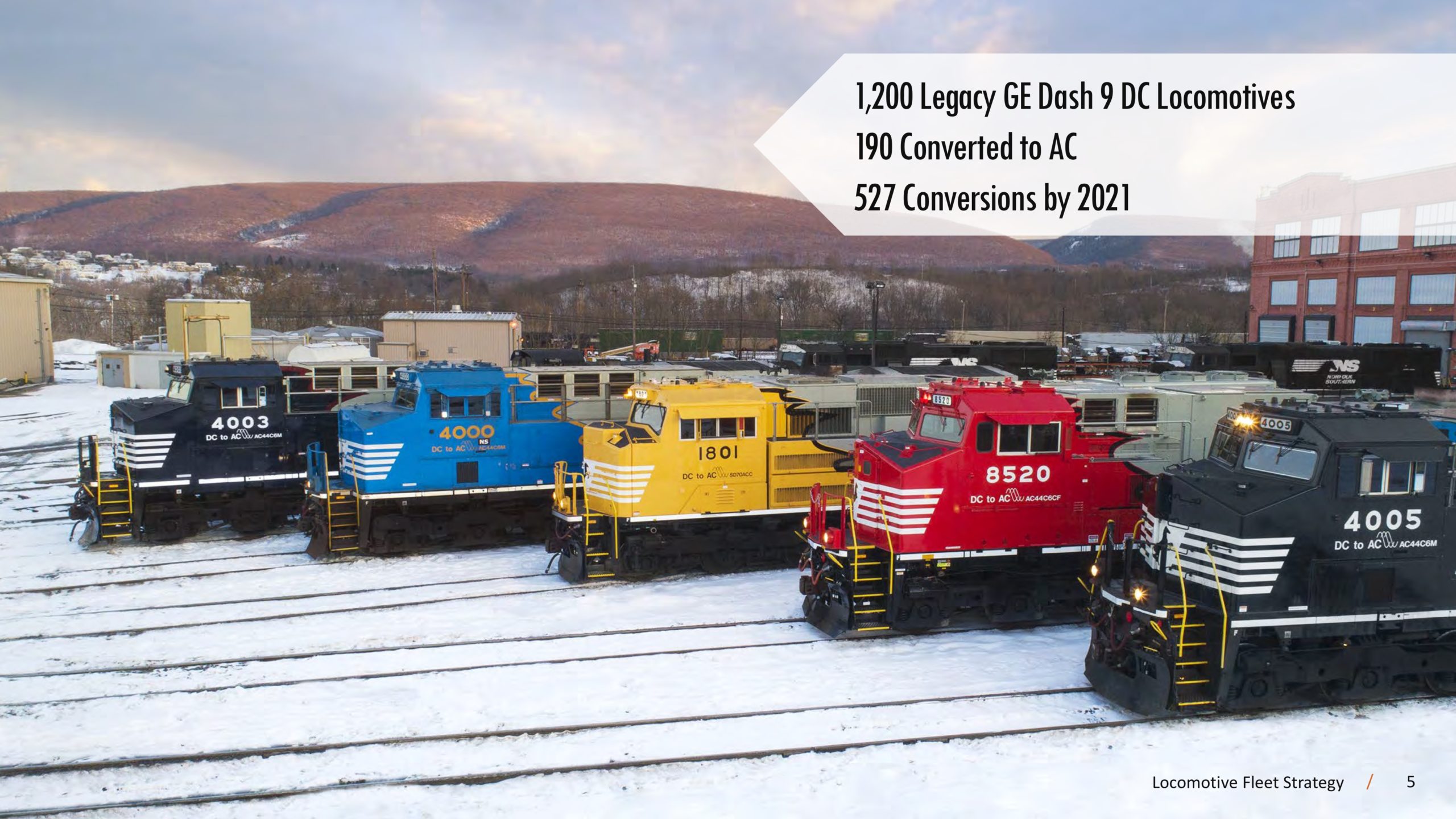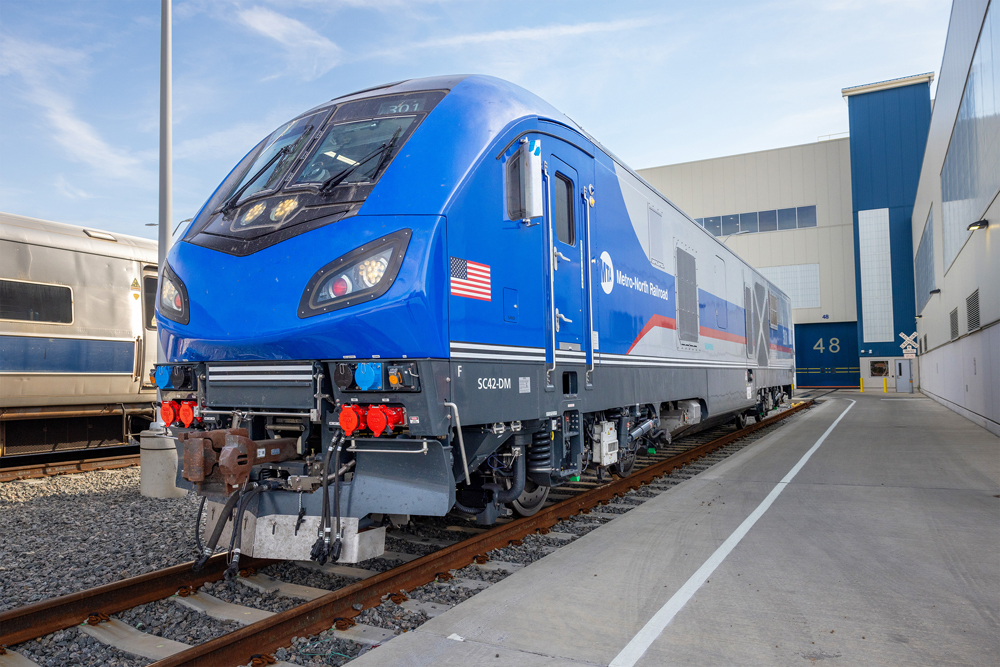Norfolk Southern’s new TOP21 operating plan will reduce the size of a locomotive fleet that will become more reliable, more productive, and spend less time in the shop, CEO Jim Squires said during the railroad’s investor day on Monday.
“We have really four initiatives under way to reduce the size of our locomotive fleet,” says Doug Corbin, assistant vice president and chief mechanical officer.
NS will run heavier trains with increased used of distributed power, continue its DC-to-AC conversion program, reduce the size of the switching fleet as local and yard service becomes more efficient, and run the same number of trains in each direction every day, which balances power requirements and keeps locomotives where they are needed.
“Through those four initiatives, we do intend to pull over 500 locomotives out of the fleet,” Corbin says.
NS aims to increase locomotive productivity by 30 percent by 2021, based on gross ton-miles per unit, and boost train length by 12 percent, to an average of 7,130 tons.
The smaller fleet will be able to handle more tonnage, Corbin says, because it will have higher tractive effort due to the near doubling of the percentage of AC-traction locomotives on the active roster.
“Computerized control of AC-traction technology gives us a huge boost in the amount of freight we can move with a locomotive with no additional horsepower,” Corbin says. “That’s the beauty of this program.”
NS will ramp up the DC-to-AC conversion program, which has completed 190 units since it began in 2016. The program allows NS to get a modern locomotive for half the cost of buying new.
“We’ve been very pleased with the results,” Corbin says.
By 2021, NS will convert 527 of its 1,200-unit fleet of DC-traction Dash 9s that were purchased between 1994 and 2004, Corbin says. That will boost the AC-traction percentage of the fleet to 61 percent, up from the current 32 percent.
The rebuilding contract runs past 2021, NS officials noted, so it’s likely that the railroad will convert more AC-traction units beyond its current three-year plan.
NS will supplement the rebuild program by buying some new locomotives, Corbin says.
By using fewer locomotives NS hopes to reduce its operating expenses at it aims for a 60-percent operating ratio by 2021, down from 65.4 percent last year.
A smaller, more reliable fleet needs fewer shop workers, Corbin explains, and AC-traction power needs fewer replacement parts than their DC-traction cousins.
And moving tonnage on fewer, longer trains also reduces fuel consumption. The practice better matches horsepower to tonnage and keeps locomotives running in their higher power range, which is more fuel efficient, Corbin says.















Reading this story brings back memories of the proponents of the first diesels presenting their advantages over steam locomotives…
Mr. Anderson: AC technologies have been a success on the development of high power, reliable, and relatively small inverters capable of operating in a very harsh environment. The inverters provide a variable frequency ac source for the motors and not a fixed frequency. The use of reliable (in the same harsh environment) computers to control the inverters systems also play a large role making ac viable on a moving platform. So while dc has some benefits ac is willing out on modern locomotives.
Oh, on the ac vs. dc for power, look into the latest developments on power transmission. You will find dc power transmission being selections for some applications.
The new locomotive order that Norfolk Southern is accepting consists of both SD70ACe Tier 3 credit units and SD70ACe-T4s from Progress Rail so Progress Rail is NOT slowly dying.
What do they plan to do with the surplus locomotives? Is there a market for such things?
The above comments are general in nature and do not form the basis for an attorney/client relationship. They do not constitute legal advice. I am not your attorney. Find your own damn lawyer.
I wish them and their new operating plan ‘Well’! Reading between the lines, the “New Plan’ has the air of more Public Relations Blather. Their mechanical folks seem to have a lot on the ball; and hopefully, this is not a stunt to sooth the stockholders, and not just an exercise in Keepinup with the neighbors[CSX].
Keep in mind that during the steam era, N & W regularly ran 200-car coal trains across its Scioto division and to Norfolk out of Roanoke. Thus the longer trains are more of a return to what they did for decades without the safety benefits of dynamic braking and distributed power of locomotives.
If they are going to reduce the fleet, They should continue to re-paint the locos into a more colorful fleet. A new Corporate upgrade in philosophy can mean a new corporate image on the locos.
Longer trains mean each derailment is more spectacular. CP is trying to clean up a runaway train that couldn’t control itself. This will continue until the FRA says “enough” and manages locomotives/ton of train.
This looks really good, on paper. A wise man once stated that the only thing that looks good on paper, are dead presidents. Implementation will be interesting. Just my humble opinion.
I hope they paint more locomotives like the ones in the picture for this article. Pure black is relatively boring.
Question for the railroaders here: if AC traction power is so much more efficient and effective than DC, why was the conversion not made long ago? After all, Tesla beat Edison in the AC/DC battle 100 plus years ago for domestic home power.
Assume part of the benefits of the DC to AC conversion allows NS to keep Tier level as originally built therefore taking advantage of old diesel engine efficiency partly negated by Tiers 3 and 4 clean air requirements. Anybody out there who knows how much that is ? Fuel costs are big part of operating and when fuel costs go up again for whatever reason operating costs will go up too. Whenever the cost and efficiencies of lithium batteries improve these converted AC locomotives might be a lifesaver for the railroads. Not in my lifetime i’m afraid…
Seeing as the slide features some of the Heritage and “special design” locomotives in the article about loco. fleet reduction, I hope this doesn’t mean that the NS Heritage loco’s won’t be among those to be mothballed!